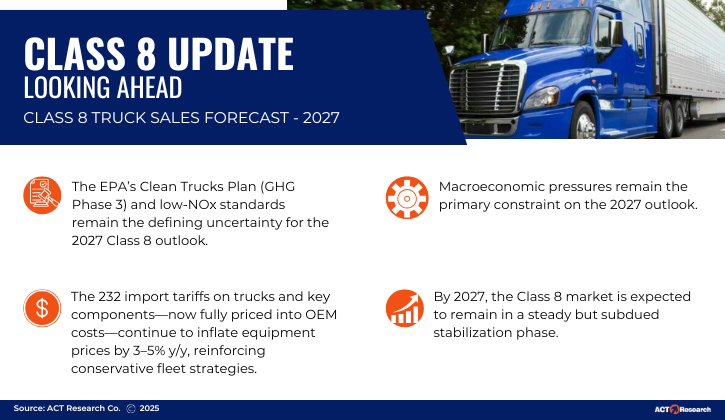
Class 8 Truck Market: 2027 Outlook
November 2025
Updated November 21, 2025
Regulatory Pressures
EPA 2027 remains the defining uncertainty for the 2027 Class 8 market. With just over a year until the scheduled implementation date, the industry still has no updated guidance from the EPA. This lack of clarity has increased expectations for a partial rollback, with most fleets assuming that technology requirements will remain in place while warranty and useful-life extensions may be delayed. This expectation has removed any meaningful prebuy activity, keeping ordering behavior centered on replacing essential equipment rather than expanding fleets.
Tariffs remain a significant cost driver heading into 2027. The 232 heavy-vehicle tariff—now fully tied to foreign-content value—continues to raise equipment costs materially. These increases do not include associated taxes, insurance, or financing, creating additional drag on capital budgets. With further tariff changes still unresolved and trade negotiations ongoing, fleet planning remains cautious and highly cost-sensitive.
With regulatory timelines still in flux and tariffs deeply embedded in market pricing, fleets are expected to maintain a defensive posture. Broader commitments are likely to remain on hold until policy clarity emerges, keeping 2027 planning conservative and replacement-driven.
Stabilized Market Growth
The Class 8 market is expected to enter 2027 in a stable but subdued position. OEMs have already reduced production in response to weak freight fundamentals and underperforming carrier profitability. Recent order activity has been below seasonal norms, keeping backlogs constrained and reducing forward visibility.
Manufacturers continue to prioritize disciplined scheduling and margin protection rather than chasing incremental volume. With 2026 unlikely to show strong upside absent a regulatory trigger, the 2027 cycle is expected to reflect steady, replacement-level demand. This includes restrained builds, tight inventory management, and controlled backlog pacing.
Fleets remain focused on maximizing returns through extended trade cycles, cost efficiency, and targeted technology adoption rather than capacity expansion. Without major policy shifts, fleet investment is likely to remain cautious through at least mid-2027, with any improvement tied to clearer regulatory guidance and a firmer freight recovery.
Economic Factors
Economic conditions remain a central constraint shaping the 2027 Class 8 outlook. Freight-producing sectors continue to lag, and the payback period following pre-tariff inventory building is contributing to weaker near-term freight volumes. Consumer activity has softened as household budgets absorb higher borrowing and price pressures.
Carrier profitability remains strained. Public TL carriers continue to report recession-like margins, reflecting elevated costs and slow freight. Access to equipment financing remains challenging, particularly for smaller fleets facing tightened lending standards.
Infrastructure and utility activity continue to provide some support for vocational demand, but long-haul freight markets remain cautious. With inventories still correcting and freight demand expected to stabilize only gradually through 2026, most fleets will enter 2027 with restrained capital budgets prioritizing maintenance, equipment life extension, and liquidity preservation.
With regulatory uncertainty unresolved and freight trends still uneven, the 2027 Class 8 outlook remains defined by operational discipline, efficiency, and risk management—rather than expansion or accelerated replacement.

Want more data?
ACT’s commercial vehicle forecast delivers the most reliable, forward-looking insight into where Class 8 truck sales are headed—helping you anticipate shifts, plan with confidence, and stay ahead of the market.